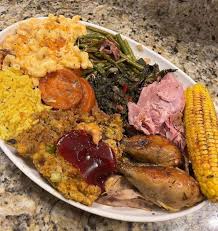If you grew up in Harlem in the 70s and 80s, food wasn’t just survival — it was a language. A rhythm. A bond. In African-American households, especially those with deep Southern roots, every meal told a story — one passed down from sharecroppers, Sunday church dinners, and Auntie’s who could feed a family of seven with a single chicken, a box of rice, and a prayer.
We didn’t have much yet more than others, but our kitchens? They were sacred spaces — even with the old stoves that barely clicked on, and pots so worn the bottoms curved in. Somehow, the food still came out right. Still rich. Still warm. Still home.
The Saturday Morning Ritual: Shopping with Strategy and Stamina
Every Saturday morning was the same: grocery day. We hit the stores like Pathmark, A&P, and/or Sloan’s with a plan and a big metal shopping cart, armed with paper food stamps folded into a rubber band or tucked in a wallet that had seen better days. The neighborhood bodegas gave you grief over what you could buy with food stamps, but places like Pathmark, C-Town, or the Associated down the avenue? That was the battlefield.

You’d walk up and down those aisles — squeezing bread for softness, checking eggs for cracks, and stretching that budget like it was elastic. Moms weren’t just shopping — they were calculating, bargaining, planning whole weeks of meals in their heads. And when that cart was full, we still had to drag it all back up those damn stairs.
That’s where the neighbors came in. The older boys or kind-hearted men always helped carry the cart up to the fifth floor. They didn’t ask for anything but got a thank you or a couple of dollars.
Cooking with Love (and Fire You Had to Light with a Match)
Back in the kitchen, the stoves were small, and half the burners didn’t always work unless you lit them with a match. Some ovens needed to be lit by hand — a risky job that involved sticking your head too close and hoping the gas didn’t backfire.A lesson I would learn is burning off my eyebrows.
But those stoves produced miracles.
The soul food staples were always there:
Fried chicken with that crackly crust and juicy inside, seasoned to perfection.
Smothered pork chops, drowning in rich gravy.
Candied yams, sweet enough to make your teeth ache.
Collard greens, slow-cooked with smoked turkey necks or a leftover ham hock.
Macaroni and cheese, baked in the oven until the top browned just right.
Cornbread — from scratch or Jiffy — always warm, sometimes with bits of corn or jalapeño.
And rice pudding — my personal favorite — with that creamy texture, a hint of nutmeg, and a thick skin on top you either loved or scraped off.
Food prep was a family affair. As a kid, you weren’t just watching — you were helping. You tore greens, peeled potatoes, rinsed beans, and stirred batters. You were in the way, sure, but also learning. Every kitchen was a classroom, and your mom or Auntie? She was the head chef and drill sergeant.
The Gathering: Everybody Got a Plate
When the food was ready, every kid in the house somehow knew. We’d gather in the living room or at the table, sometimes on the floor, plates in our laps. Nobody asked if you were hungry — you just got a plate. That was the rule.
Siblings and Cousins, we all ate together, elbow to elbow, yelling over each other, dripping sauce on the couch. Adults sat in the kitchen or leaned on door frames, plates in hand, soda in plastic cups.
Kids Drank Kool-Aid, Adults Had Pepsi
Back then, alcohol wasn’t a thing in my homes, not like today. Maybe my uncle had a six-pack in the fridge, or a bottle of Bacardi Dark Rum hidden in the back of the cabinet, but mostly? Adults drank soda — Pepsi, Coca-Cola, RC Cola, or a grape Shasta if you were on a budget.
Kids drank Kool-Aid — mostly fruit punch, mixed in that cloudy plastic pitcher that never really got clean, no matter how many times you washed it. There was always way too much sugar. And we wouldn’t have had it any other way.
Snacks Were a Whole Mood
We didn’t snack fancy, but we snacked well. Our sweets had names and fans:
Hostess cupcakes and Twinkies, wrapped in that crinkly white cellophane.
Entenmann’s cakes, especially the crumb-topped or the chocolate-covered donuts.

Breyers ice cream — with those little black vanilla bean specks in every scoop.
Now & Laters, Alexander the Grape, Lemonheads, Boston Baked Beans — that candy that stuck to your teeth for hours.
Fudge rounds, Oatmeal Creme Pies, Little Debbie Swiss Rolls — the little luxuries packed in the bottom shelf snack bin.
You ate what your family could afford that week, and you shared with your friends, or fought over the last one.
More Than Meals: It Was Memory-Making
Looking back, we didn’t have gourmet ingredients or high-end kitchens. We had flimsy aluminum foil, burnt baking pans, scratched-up Tupperware, and dented pots that had survived three moves. But the food that came out of those Harlem kitchens? It could make you cry. It could raise your spirit. It could bring a whole building together.
Food was how we loved each other. How we showed up. How we remembered where we came from — even if we were five flights up, in a tiny apartment, cooking on a broken stove.
We ate together.
We grew up together.
And every bite carried a little piece of Harlem’s soul.
That’s what we were really hungry for.















